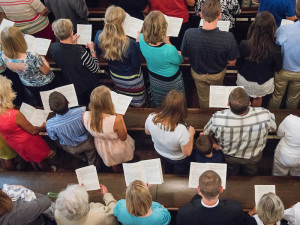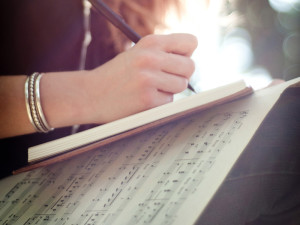by Mr. Jonathan Swett
 Allow me to be the first church musician you’ve heard instruct you NOT TO SING the hymns.
Allow me to be the first church musician you’ve heard instruct you NOT TO SING the hymns.
Or perhaps you are one that ‘can’t carry a tune in a bucket’ and have had the unfortunate experience of being chastised for daring to lift your voice in praise to God, and thus this is not the first time you’ve been instructed as such—for which I apologize on behalf of that chastisement-hurling individual. Each of us is blessed with various and unique gifts of the Holy Spirit and though singing in tune may not be your gift, it is not any less worthy to the ears of our Creator!
Of course, I need to take my opening instruction a step further and encourage you NOT TO SING the hymns … AT FIRST!
Music is a wonderful gift of God to be used to carry His Word and is very effective at doing just that. But at different times and in different circumstances the music to a hymn may be distracting and I encourage each of you to first READ the hymn in its carefully crafted poetic form. Don’t get me wrong, this doesn’t mean not to sing during the service, but rather to reflect on the text at home in personal devotion, in the nave before service starts, or even during the musical introduction to each hymn. The point is to gain a better understanding of the text by itself so that when joined with the melody and accompaniment a more fulfilling experience will result.
“We All Believe in One True God” (LSB 954) is an excellent candidate for this practice. Based on the Nicene Creed, it will be interesting to note how the paraphrased text connects to the creed that we confess each Divine Service. Also, sung to a somewhat difficult chant melody, it will be easier to fit the words with the notes if you first have a modest understanding of the theme, poetic flow, and construct of the text by itself. This little bit of extra effort on your part will go a long way in fostering a confidence in the singing of your congregation as a whole and a mutual edification in the dialogue of receiving and returning God’s Word in glorious song!
As the basis for “We All Believe in One True God,” Martin Luther used the first two lines of a single-stanza German medieval hymn first found with Latin and German words in 1417 and expanded it to three stanzas—individually paraphrasing each of the three articles of the creed. The text was first published in Johann Walter’s Geysliche gesangk Buchleyn (1524) and was given as a substitute for the Latin Credo of the mass in Luther’s German Mass of 1526. The melody is in the Dorian mode originating in the plainsong setting of the creed, “Credo in unum Deum,” and was adapted by Luther or Walter to fit the paraphrased text.
 Take the time this week to read and study a hymn for your upcoming worship. Ideally, a list of hymns for the coming service can be provided by your Pastor, musician, or secretary. Perhaps you can even kindly request for this information to be included at the end of the worship bulletin or in the announcements page each week. I believe that, much like the study of Scripture, you will unlock an understanding beyond the surface that will aid you as you sing to our Creator and discover each hymn in a new and profound way.
Take the time this week to read and study a hymn for your upcoming worship. Ideally, a list of hymns for the coming service can be provided by your Pastor, musician, or secretary. Perhaps you can even kindly request for this information to be included at the end of the worship bulletin or in the announcements page each week. I believe that, much like the study of Scripture, you will unlock an understanding beyond the surface that will aid you as you sing to our Creator and discover each hymn in a new and profound way.
Jonathan A. Swett is Kantor of Our Savior Evangelical Lutheran Church and School, Hartland, MI.
Source of historical information:
Stulken, Marilyn Kay. Hymnal Companion to the Lutheran Book of Worship. Philadelphia: Fortress Press, 1981.
